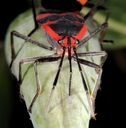Large Milkweed Bug
Oncopeltus fasciatus
Classification
- Phylum: Arthropoda
- Subphylum: Hexapoda
- Class: Insecta
- Order: Hemiptera
- Suborder: Heteroptera
- Infraorder: Pentatomomorpha
- Superfamily: Lygaeoidea
- Family: Lygaeidae
- Subfamily: Lygaeinae
- Genus: Oncopeltus
- Species: fasciatus
Pronunciation
How to pronounce Oncopeltus fasciatus: //ˌɒŋkoʊˈpɛltəs fæsiˈeɪtəs//
These audio files are automatically generated. While they are not always 100% accurate, they are a good starting point.
Images






Summary
Oncopeltus fasciatus, commonly known as the large milkweed bug, is a striking insect noted for its black and orange coloration and its specialized diet on milkweed seeds. It exhibits unique life history traits influenced by geographic and climatic conditions, including migratory behaviors and reproductive strategies.
Physical Characteristics
Adults are black and orange; leathery portion of forewing has orange triangles separated by a black band. Nymphs are bright orange with growing black spots. Eggs are oblong with three downcurved projections, changing color from yellow to orange to bright red before hatching.
Identification Tips
Distinct red/orange and black X-shaped pattern under the triangle on their wings serves as an aposematic warning. Males have a black band on the ventral side of the fourth abdominal segment while females have two black spots in that location.
Habitat
Disturbed areas, roadsides, open pastures, usually near milkweed plants.
Distribution
North America, ranging from Central America through Mexico and the Caribbean to southern Canada. Costa Rica marks the southern limit of distribution.
Diet
Specialist herbivore feeding primarily on milkweed seeds (Asclepias spp.) and capable of consuming sunflower, watermelon, cashew, etc.
Life Cycle
Hemimetabolous insect with four nymphal stages over 28-30 days before becoming adults. Lifecycle varies with geographic location affecting clutch size and reproductive success.
Reproduction
Females lay about 30 eggs a day in milkweed seed pods; total egg production over a lifespan can reach about 2,000 eggs. Reproduction occurs continuously in favorable climates and seasonally in temperate zones, producing one to three generations per year based on the environment.
Predators
Predators can be deterred by their aposematic coloration, as they accumulate toxins from milkweed making them distasteful to potential predators.
Ecosystem Role
Serves as a herbivore that plays a role in the dynamics of plant communities, particularly those involving milkweed plants.
Evolution
This species exhibits strong selection for survival traits that adapt to varying environmental factors; has been a model organism for evolutionary studies due to its hemimetabolous nature.
Misconceptions
Often mistaken as harmful due to their bright colors, they are actually beneficial herbivores involved in their ecosystems.
Tags
- Oncopeltus fasciatus
- Large Milkweed Bug
- Hemiptera
- Lygaeidae
- Insects